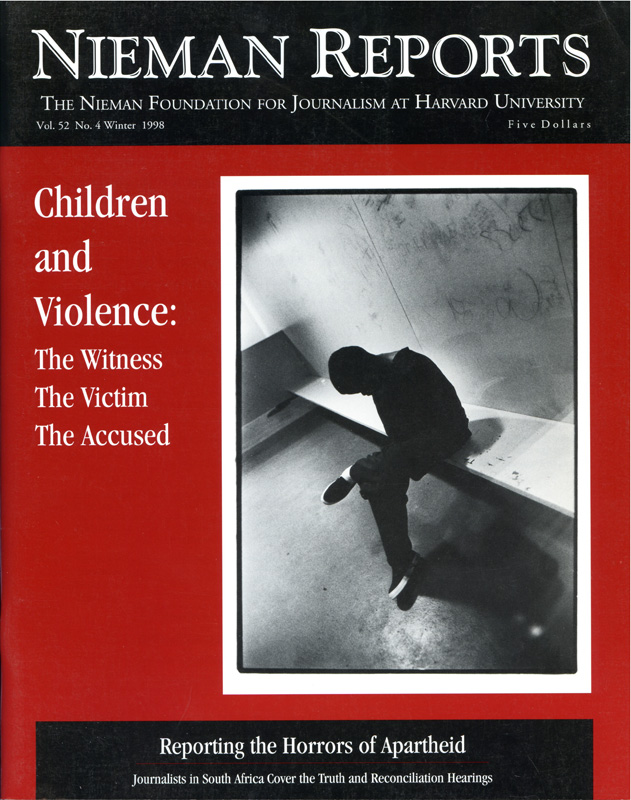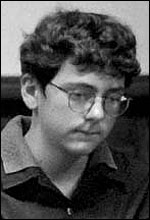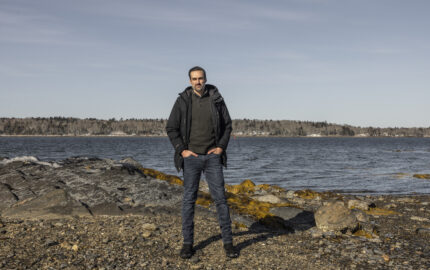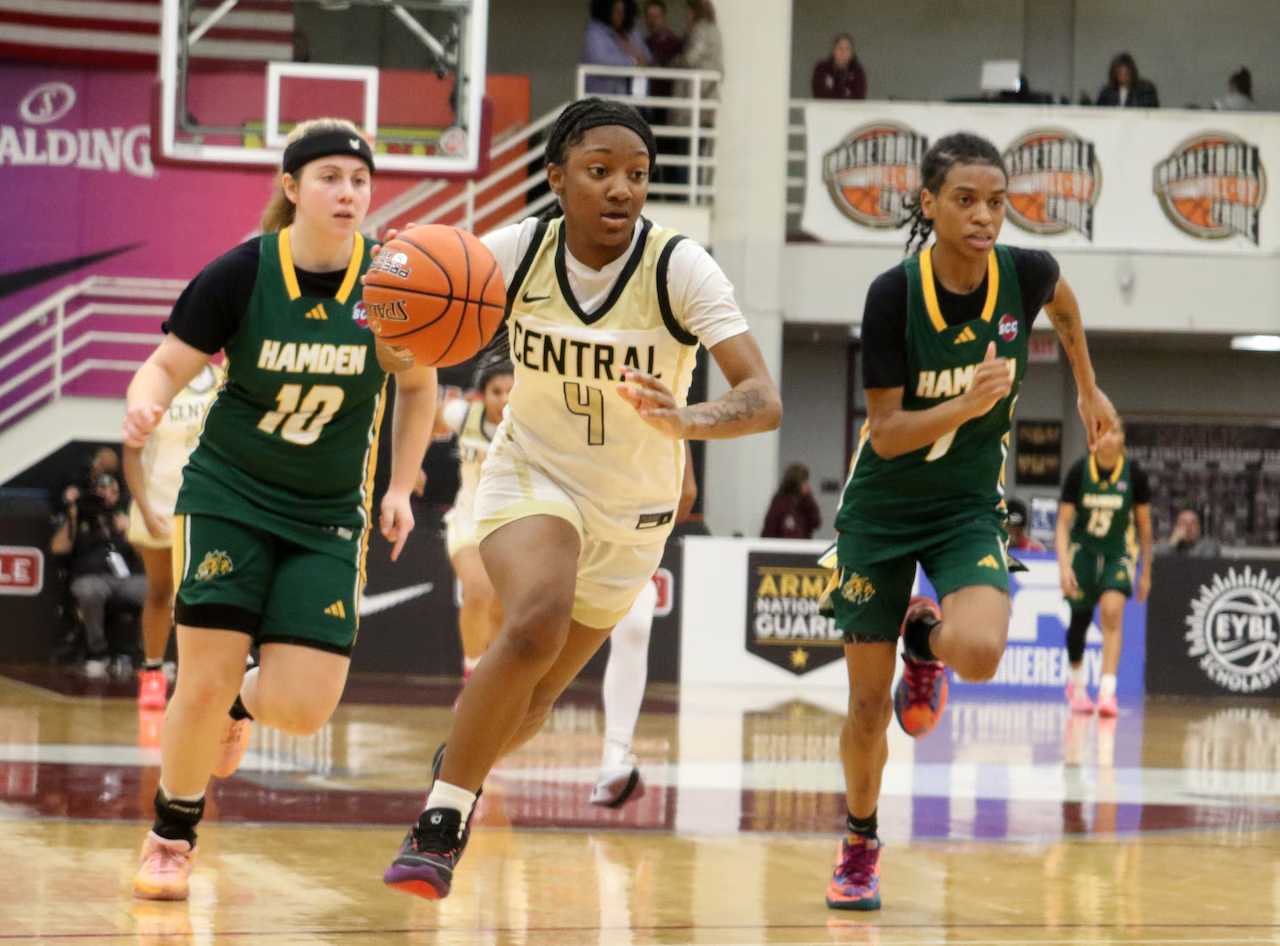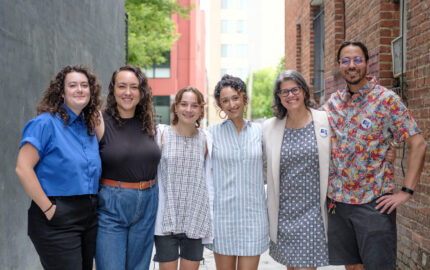No one had a hint of—and to this day even he cannot describe— the demons haunting 14-year-old Michael Carneal’s soul. But on December 1, 1997, the first day of school after a quiet and unseasonably warm Thanksgiving weekend, this seemingly ordinary child from a well-respected family slipped up behind the pre-school prayer circle that voluntarily assembles at Heath High School each morning. He calmly inserted earplugs, reached into his backpack, and pulled out a .22 semi-automatic pistol. At the instant the prayer leader said “Amen,” he fired 10 shots from close range into a group that included several of his best friends. For a small pistol wielded by a small boy, the lethality was shocking.
It became our job to explain this tragedy to the community and, as it turned out, to shape the way it was described to the nation. The Paducah Sun is a regional morning newspaper with a daily circulation of 30,000. Its news and editorial staff numbers 32, including 10 reporters, three photographers and three sports writers.
The scene in our newsroom that day still seems surreal. We are thinly staffed on Monday mornings because of our reporting cycle. On this morning the newsroom was almost empty, except for a blaring police scanner heard by Executive Editor Karl Harrison. Soon he was fervently punching reporters’ phone numbers and sending them scrambling to cover this developing story.
Even as authorities talked in confused terms over the scanner, newspaper controller David Mathis walked into the newsroom. He was speaking on a cell phone with his son Trent, a student at the high school, who was also on a cell phone. Trent was 20-feet away when the shooting started, and he became our first eyewitness source. Trent told his father who had been shot and how badly. As events unfolded, coverage of this chilling story continued to intersect with our personal lives. Our executive editor’s wife had taught some of the victims, and that day some of the siblings of the slain and injured students were in her classroom. Some of our employees had children at Heath.
Despite this high level of personal anguish, decisions about who to assign to cover it were not tough to make. We assigned everyone we had, leaving only a skeletal staff to keep an eye out for other news. Matters weren’t made any easier by the fact that we were short-staffed. Four key staffers were in Utah beginning two weeks of computer-system training. We considered bringing them back, but decided against it. Were we faced with that decision again, we’d bring back our design editor. We not only missed his special skills but the time top editors spent trying to do his job by committee would have been better applied working with reporters and photographers.
Throughout our 16 hours of first-day coverage, the editor, executive editor, city editor and acting copy desk chief met several times to map coverage. We employed the “Maestro Concept,” deploying our reporters to try to answer some four or five key questions our readers were likely to have about the case. We wanted each of these themes to be visible on page one, either embedded in a story, a headline or a pull quote. The most compelling of these became our day-one headline. In four-inch type, floated in white space that spanned the entire page, we printed the word “Why?”
Our day-one edition, painstakingly planned and assembled by so many different people, was widely praised and, as best we know, factually accurate in every detail. The importance of our accuracy was driven home the next day when we learned that the Louisville newspaper, which had flown in its own team of reporters, had published a photo of a teenager who was uninvolved in the tragedy and misidentified him as Michael Carneal. Worse, the Associated Press opted to go with that newspaper’s photo. It was also picked up by national and international media.
We had it right. Everyone else had it wrong. This was not the sort of thing an editor gloats over, but it was a moment when I gave thanks for the expertise of my staff. An out-of-town newspaper can eventually live down such blunders but for a local newspaper, such damage to our credibility would have been irreparable.
Coverage became easier to manage after the first day. Critical elements of the story began to emerge because of the experiences and expertise of our beat reporters. For example, our obituary writer, Linda Cocke, became an invaluable resource because of relationships she’d built with the funeral directors. She used her contacts as go-betweens with the slain girls’ families as we worked out ground rules for coverage. Her work, as well as some persuasion by the executive editor, made us the only print media allowed to have a photographer and reporter in the church during the funeral service.
We relied on our more experienced reporters to cover the courthouse, sheriff and prosecutor. We added to this mix our top investigative reporters, Bill Bartleman, a 25-year veteran of The Sun and James Zambroski, a crime specialist. Experience does pay off. From the start, Bartleman, the lead reporter, reminded the others that it would not be enough for us to stay even with the national media on this story. This was our turf, he said. We’d be expected to have better sources and better information. Stories the national media told at night should be ones we broke earlier that day.
In the days that followed this team produced a string of seven copyright, exclusive stories. Notable among them were the sheriff’s disclosure that he believed Carneal did not act alone (in grand jury testimony, no proof emerged that others conspired with or helped Carneal), the revelation that Carneal referred to a scene in the obscure film “The Basketball Diaries” to explain his actions, and the first interview with a shooting survivor, who had been paralyzed. We led coverage so often that one of the networks cut a deal with a copy editor to bring our latest edition from the press room to their hotel on the way home from his shift, which ended at one in the morning.
Naturally when a tragedy occurs, one question is always asked: What can we do to keep this from happening again? The most common reaction (and many times a correct one) in the wake of tragedies is for a newspaper to launch a crusade for change. Instead, as events unfolded, we found ourselves a bit on the other end, advocating more security, but cautioning against extreme measures that would provoke even greater fear among children.
Editorially, we advocated adoption of key pieces of a school violence prevention plan that was modeled on a North Carolina program and has been put on the state legislative agenda. While this overall initiative got stalled because of a side issue, a committee of parents and school officials in our community put into place in our schools some of the components of that plan. These measures include security officers posted at each of the three high schools, armed and casually uniformed, photo ID badges for all students, faculty and staff, controlled entry and exit to school parking lots, and an anonymous tip line for students to report threats by other students. Metal detectors were not set up because community members did not feel their schools should become prisons because of Michael Carneal.
At our newspaper, coverage of the schools and youth in our community has not changed. We still have one reporter assigned full time to report on what is happening in our classrooms (as opposed to covering just school board meetings). Obviously this tragedy has made us, as watchdogs in our community, more sensitive to what is happening among our young but our daily assignments and duties have not been changed by it.
Jim Paxton is Vice President and Editor of The Paducah Sun, flagship newspaper of the family-owned Paxton Media Group, which publishes 25 daily newspapers in nine states.
It became our job to explain this tragedy to the community and, as it turned out, to shape the way it was described to the nation. The Paducah Sun is a regional morning newspaper with a daily circulation of 30,000. Its news and editorial staff numbers 32, including 10 reporters, three photographers and three sports writers.
The scene in our newsroom that day still seems surreal. We are thinly staffed on Monday mornings because of our reporting cycle. On this morning the newsroom was almost empty, except for a blaring police scanner heard by Executive Editor Karl Harrison. Soon he was fervently punching reporters’ phone numbers and sending them scrambling to cover this developing story.
Even as authorities talked in confused terms over the scanner, newspaper controller David Mathis walked into the newsroom. He was speaking on a cell phone with his son Trent, a student at the high school, who was also on a cell phone. Trent was 20-feet away when the shooting started, and he became our first eyewitness source. Trent told his father who had been shot and how badly. As events unfolded, coverage of this chilling story continued to intersect with our personal lives. Our executive editor’s wife had taught some of the victims, and that day some of the siblings of the slain and injured students were in her classroom. Some of our employees had children at Heath.
Despite this high level of personal anguish, decisions about who to assign to cover it were not tough to make. We assigned everyone we had, leaving only a skeletal staff to keep an eye out for other news. Matters weren’t made any easier by the fact that we were short-staffed. Four key staffers were in Utah beginning two weeks of computer-system training. We considered bringing them back, but decided against it. Were we faced with that decision again, we’d bring back our design editor. We not only missed his special skills but the time top editors spent trying to do his job by committee would have been better applied working with reporters and photographers.
Throughout our 16 hours of first-day coverage, the editor, executive editor, city editor and acting copy desk chief met several times to map coverage. We employed the “Maestro Concept,” deploying our reporters to try to answer some four or five key questions our readers were likely to have about the case. We wanted each of these themes to be visible on page one, either embedded in a story, a headline or a pull quote. The most compelling of these became our day-one headline. In four-inch type, floated in white space that spanned the entire page, we printed the word “Why?”
Our day-one edition, painstakingly planned and assembled by so many different people, was widely praised and, as best we know, factually accurate in every detail. The importance of our accuracy was driven home the next day when we learned that the Louisville newspaper, which had flown in its own team of reporters, had published a photo of a teenager who was uninvolved in the tragedy and misidentified him as Michael Carneal. Worse, the Associated Press opted to go with that newspaper’s photo. It was also picked up by national and international media.
We had it right. Everyone else had it wrong. This was not the sort of thing an editor gloats over, but it was a moment when I gave thanks for the expertise of my staff. An out-of-town newspaper can eventually live down such blunders but for a local newspaper, such damage to our credibility would have been irreparable.
Coverage became easier to manage after the first day. Critical elements of the story began to emerge because of the experiences and expertise of our beat reporters. For example, our obituary writer, Linda Cocke, became an invaluable resource because of relationships she’d built with the funeral directors. She used her contacts as go-betweens with the slain girls’ families as we worked out ground rules for coverage. Her work, as well as some persuasion by the executive editor, made us the only print media allowed to have a photographer and reporter in the church during the funeral service.
We relied on our more experienced reporters to cover the courthouse, sheriff and prosecutor. We added to this mix our top investigative reporters, Bill Bartleman, a 25-year veteran of The Sun and James Zambroski, a crime specialist. Experience does pay off. From the start, Bartleman, the lead reporter, reminded the others that it would not be enough for us to stay even with the national media on this story. This was our turf, he said. We’d be expected to have better sources and better information. Stories the national media told at night should be ones we broke earlier that day.
In the days that followed this team produced a string of seven copyright, exclusive stories. Notable among them were the sheriff’s disclosure that he believed Carneal did not act alone (in grand jury testimony, no proof emerged that others conspired with or helped Carneal), the revelation that Carneal referred to a scene in the obscure film “The Basketball Diaries” to explain his actions, and the first interview with a shooting survivor, who had been paralyzed. We led coverage so often that one of the networks cut a deal with a copy editor to bring our latest edition from the press room to their hotel on the way home from his shift, which ended at one in the morning.
Naturally when a tragedy occurs, one question is always asked: What can we do to keep this from happening again? The most common reaction (and many times a correct one) in the wake of tragedies is for a newspaper to launch a crusade for change. Instead, as events unfolded, we found ourselves a bit on the other end, advocating more security, but cautioning against extreme measures that would provoke even greater fear among children.
Editorially, we advocated adoption of key pieces of a school violence prevention plan that was modeled on a North Carolina program and has been put on the state legislative agenda. While this overall initiative got stalled because of a side issue, a committee of parents and school officials in our community put into place in our schools some of the components of that plan. These measures include security officers posted at each of the three high schools, armed and casually uniformed, photo ID badges for all students, faculty and staff, controlled entry and exit to school parking lots, and an anonymous tip line for students to report threats by other students. Metal detectors were not set up because community members did not feel their schools should become prisons because of Michael Carneal.
At our newspaper, coverage of the schools and youth in our community has not changed. We still have one reporter assigned full time to report on what is happening in our classrooms (as opposed to covering just school board meetings). Obviously this tragedy has made us, as watchdogs in our community, more sensitive to what is happening among our young but our daily assignments and duties have not been changed by it.
Jim Paxton is Vice President and Editor of The Paducah Sun, flagship newspaper of the family-owned Paxton Media Group, which publishes 25 daily newspapers in nine states.
